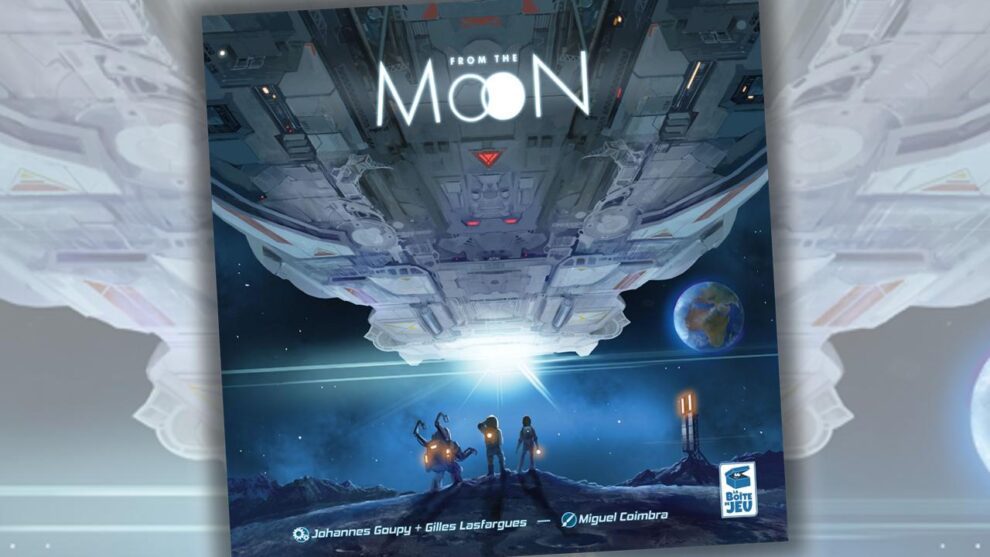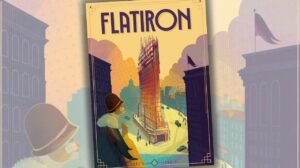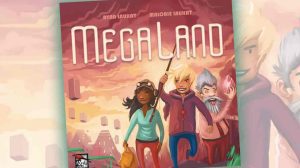Disclosure: Meeple Mountain received a free copy of this product in exchange for an honest, unbiased review. This review is not intended to be an endorsement.
Do you like sci-fi themes in your tabletop experiences? If so, I think 2024 has been an exceptional year. Shackleton Base: A Journey to the Moon might end the year as the best Euro-style strategy game I got to the table. SETI: Search for Extraterrestrial Intelligence was great as well, especially at lower player counts. Maybe you’ve heard of a little-known game called Arcs? Heck, as good as Arcs was, it didn’t excite me the way Andromeda’s Edge did.
In other years, any one of those games might end up being the year’s best game. I’m already stressed out as I think about which of the above-mentioned games is my favorite of the bunch.
You’ve probably heard the expression “it’s all about timing” and in the case of the new sci-fi themed strategy game From the Moon (2024, La Boite de Jeu), the timing for my plays could not have been much worse.
That’s not because From the Moon is bad. In fact, across my two review plays (I tried From the Moon with four players and once solo before realizing I didn’t need a third play to know where I landed), I knew just a few turns in that the game was a by-the-numbers worker placement game that had shades of area majority scoring and tableau building through a tile system that gives players the chance to trigger a nice river of combos during play.
Add in public milestones, variable player powers, and a recall system that triggers a player’s income and pushes the entire table towards the end game, and all of it gives From the Moon a feel of familiarity that was welcome at my table. The game’s major standout is its production, but at a cost that will make you think twice before dropping some coin on a purchase.
That puts From the Moon in a tough spot. It’s a nice time, but in comparison to such an incredible slate of sci-fi themed games this year, it’s hard to make a firm recommendation.
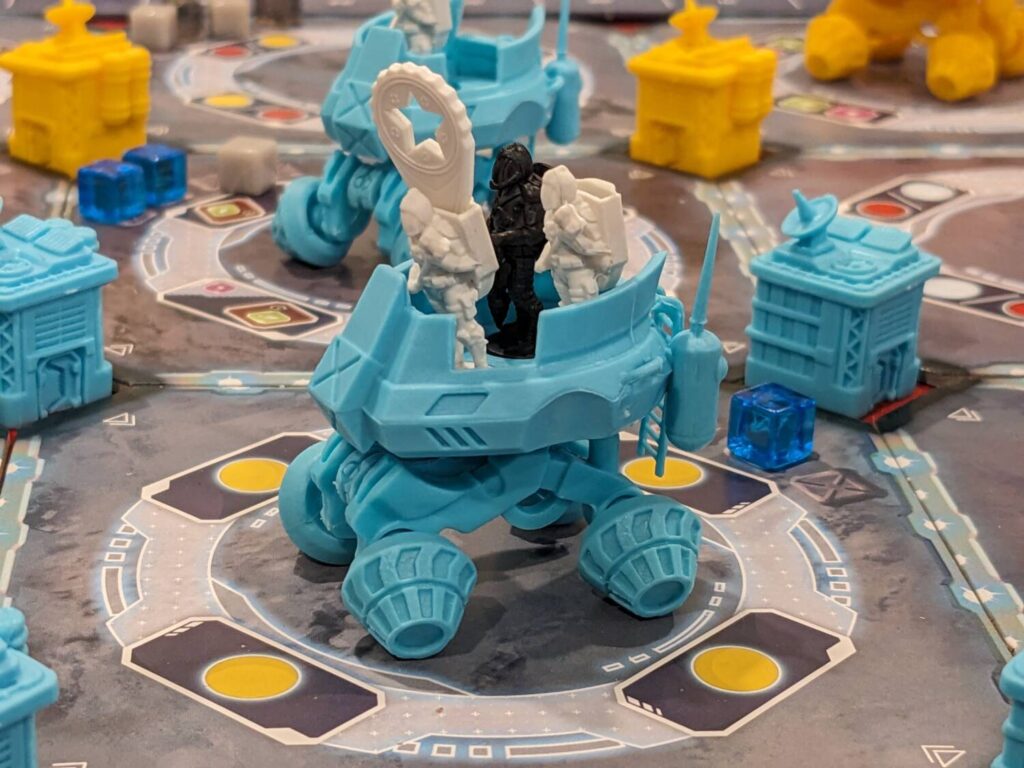
To the Stars
From the Moon is a 1-4 player worker placement game that also offers a large menu of actions via “recipe fulfillment.” You’ll all run around and grab stuff, so that all players can help contribute towards three moon missions that score instant bonuses as well as an area majority bonus for the player or players who contribute the most to each mission. This might be a mix of delivering specific types of astronauts, various resources that are gathered on the moon, or food that will be grown in a player’s greenhouses throughout play.
Player turns at first feel very basic: send one of three rover miniatures to a terrain tile in the modular map (scaled up or down, based on player count) to take actions. Based on the type and number of astronauts in each rover, a player might take anywhere from 1-6 actions as they collect resources from a terrain space, trigger the main action of the space, or take better actions if a player has trained their astronaut to become a specialist, essentially doubling the number of actions that astronaut can take when placed with a rover.
But From the Moon offers players a chance to take many more different actions on their turn. One could purchase “Foundation” tiles that can turn a player’s personal board into a separate action tableau with the purchase of Laboratory tiles that trigger additional actions each time a Laboratory is added to the Foundation tableau. The Laboratory combos were my favorite part of From the Moon’s design. In both my games, I was excited to create a small tableau that offered not only small/minor actions—grab a water resource here, upgrade a greenhouse to double its production there—but more robust turns, where a player could fulfill part of a moon mission to score a few points.
Unfortunately, the number of actions doesn’t stop there. Players can build structures that provide additional income, they can build greenhouses (yep, you’re right—a greenhouse is a structure, but constructing a greenhouse is a separate action!), they can hire and/or train additional astronauts, or they can pass. The pass action triggers income for the active player only, and progresses that player down a track that will eventually end the game if a player ever passes while in the final space of this area of the board. During income, players also have to feed all their astronauts—From the Moon is also a “feed your people” game, like Agricola!!–or lose a sizable number of points in the process.
It’s not too much, but it IS a lot. From the Moon doesn’t do itself any favors, either—there’s not a player aid in sight, and the back of the manual wasn’t enough to save players from asking a ton of questions during that four-player game.

Where’s the Wow?
From the Moon—which ran a hair under three hours at four players—was an average-to-above average time at the table in terms of its gameplay. There wasn’t anything on display that turned me on or made another player yelp with approval after taking a turn. For an experienced gamer who plays a lot of medium-to-heavy strategy games, From the Moon didn’t do anything particularly novel.
But From the Moon whooped tail as a production. Save for the lack of player aids, I thought From the Moon nailed everything else as a physical toy. The rovers are nice and chunky, standing out as an item that even my children wanted to play with when they saw the game set up on the table. The rover seats three astronaut figures, and full rovers look great. The astronaut figures each have a backpack on, and those backpacks hold large specialist tokens that call out a trained astronaut so that all players can easily tell how many actions each astronaut can take.
The player boards shine, too. There’s a nice track at the bottom for energy usage, right down to a spot for a player’s current energy total with a carved-out spot for the circular energy token. Building out the Foundation/Laboratory tableau is easy, and looking at an opponent’s income from across the table is a snap.
When added to the main terrain map, I loved the way buildings made the whole look of From the Moon stand out. The terrain map—a 4×4 tile grid with four players, or a 3×3 grid with 1-2 players—looked gorgeous and colorful. Passers-by really might feel like a moon colony was built out by the end. The main board makes it easy to tell what the current bonus milestones are for each player, and the large public buildings available to all players are displayed nicely at the edge of the main score tracker. Cute little ship tokens are used to track score as well as round progress, and because each player is always at a different stage of play (players only progress when they choose to pass and gather income), it was easy to tell how close each game was to completion.
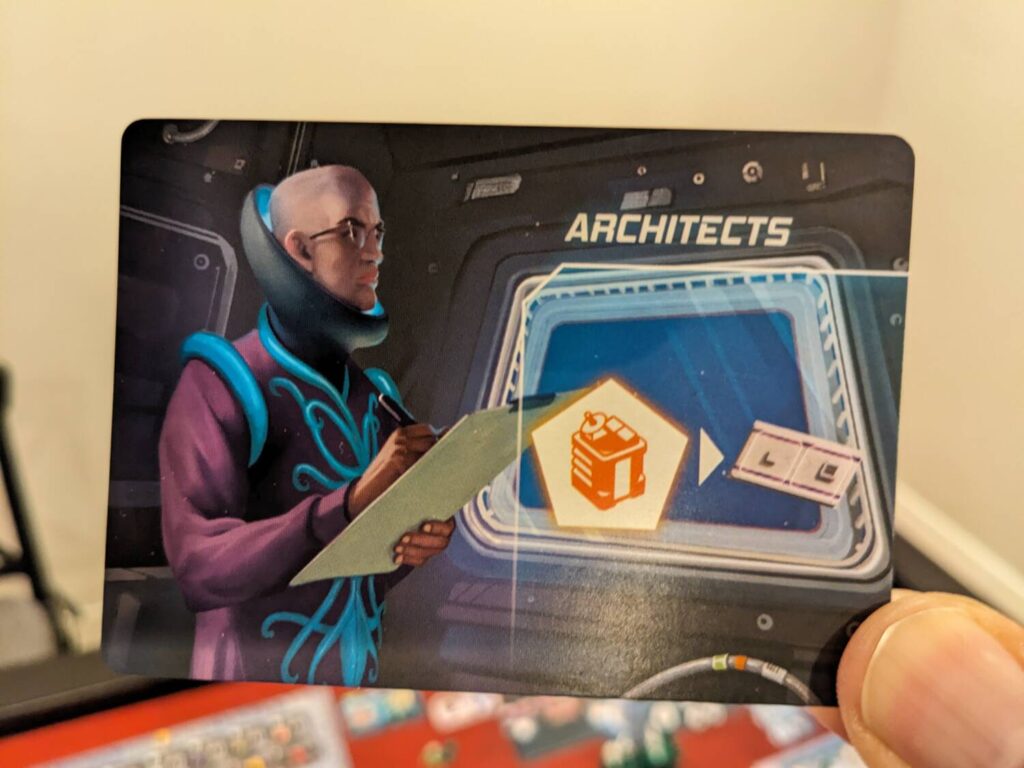
The storage solution is great. The main rulebook is pretty good, with lots of good examples. The individual player storage is a cinch and the administration of solo play is very simple, to the point where there is almost no in-game management of the opposing player.
As you might expect, all this comes at a cost. Two of the three players who joined me for the four-player game of From the Moon asked about the financials during play.
“Lay it on me,” one player started. “How much does this cost online?”
We went to Google to pull the stats. “About ninety bucks,” I responded.
Publishers always ask me what price makes people think twice before clicking the purchase button on a new game. At my tables, we talk about game prices a LOT, because across my five game groups, the general feeling is that game prices are spiraling out of control. The idea that price is not an object? Certainly this is true when a player is a diehard about a certain designer, game series, or theme. “Oh, the new game from [insert celebrity designer name here]? I’ll pay anything for that because I love their games.”
So, we aren’t talking about those people. We are talking about people who try a game, then want to know how much the price is…and what price scares them away, even if the demo or first play for a game goes well.
For me, that number depends on the game category. For a card game, that number is $30. If a trick-taker costs that much money, I often hesitate before backing away from the register. (This just happened to me at SPIEL 2024.) For most other types of games, that number is $70. That means if I try a game, like it, and learn the price is, say, $49.99, I’m probably buying it anyway…that price isn’t too bad, I’ll get a few plays out of it, then move it in a math trade or donate it to a friend or game library.
From the Moon lands in a tricky price point area. When I told the other players that the game is about $90, one could tell that these players were not about to pull the trigger. “Whoosh, ninety? I like this, but that’s a little hefty,” one player said. The production is an A+, and it’s easy to see how the game price needs to land in that range. But at $90, a player then has to justify a few other things, namely this—will my new toy get to the table often enough to make the price worth it?

Fun, But Not Standout
From the Moon is enjoyable. My feelings were cemented early on—it’s a good time at the table, but in a sea of other worker placement games with a nice production and a sci-fi theme, I might recommend other games that were released this year alone, namely Andromeda’s Edge, which can be had for a lower price point and offers an exceptionally deep, fun and variable experience.
From the Moon’s best attribute is its production, and at three players, I think it would offer a very streamlined experience for fast players. In addition to the Laboratory chaining mechanic, the player powers do give players a chance to attack the game in very different ways, which I appreciated. Sometimes, these variable player powers in a Euro are not that unique, but some of the ones in From the Moon are wild—the Cyborgs don’t have to feed their workers during the pass action, while the Unifier faction lets a player greatly increase their ability to bring new astronauts into the game after fulfilling parts of a moon mission.
Believe it or not, my strong advice with From the Moon is to wait for its price to come down a bit. Like most games, I expect From the Moon will find itself on sale in the months ahead, making this an easier recommendation as the price comes down a tad. At $50 or $60, it is more in line with similar titles and that might be its sweet spot. Be sure to visit BGG to find a player aid in the game’s Files area. By now, I’m sure there are player-designed aids that can fill the gap left by the lack of player aids included in the original box.
From the Moon does some nice things. I wish I had played it before I got to some of the year’s other standout titles, but in life, it’s all about timing!


